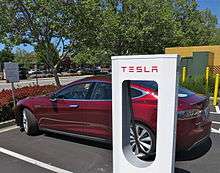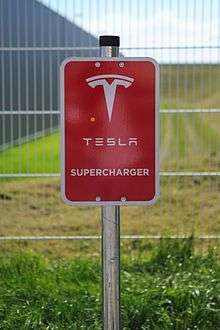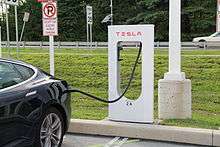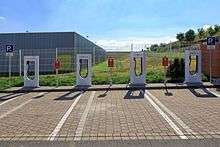Tesla station

A Tesla station or Tesla Supercharger station is a network of 480-volt fast-charging stations built by Tesla Motors to allow longer journeys for their all-electric manufactured vehicles (Model S and Model X), through quick charging of the vehicle's battery packs. Tesla began building the network in 2012. As of 13 September 2016, there were 705 stations globally, with 4,359 chargers.[1] The Supercharger is a proprietary direct current (DC) technology that provides up to 120 kW of power per car (depending on circumstances),[2] giving the 90 kWh Model S an additional 170 miles (270 km) of range in about 30 minutes charge and a full charge in around 75 minutes.[3] A software update provided in 2015 to all Tesla cars uses demand information from each Supercharger station to plan the fastest route, if charging will be necessary to reach the destination.[4]
Supercharging is free, once the option is purchased, for all Tesla cars ordered before January 1, 2017. Cars that are ordered from 2017 onwards will be limited to free 400 kWh (about 1,000 miles or 1,600 km) per year. Beyond that, supercharging will be charged, but at a lower price than filling up a gas car.[5]
Tesla Supercharger network
Technology

Tesla supercharging stations charge with up to 145 kW of power, or up to 16 times as fast as public charging stations; they take about 20 minutes to charge to 50%, 40 minutes to charge to 80%, and 75 minutes to 100%. The charging stations provide high-power direct-current (DC) charging power directly to the battery, bypassing the internal charging power supply.[6]
Some of the Tesla supercharging stations use solar panels to offset energy use and provide shade. In the next few years after 2014, Tesla Motors plans to cover more stations with solar canopies to charge the Tesla vehicle as long as the vehicle is equipped with a supercharging system. The cost for using the supercharger is covered with the purchase of the car with the purchase of 60 kilowatt-hours models or higher.[6] The network is exclusive to Model S and Model X sedans. Supercharging hardware is standard on Model S vehicles equipped with a battery of 70 kWh or greater, and optional (with a one-time payment of US$2,000) on Model S vehicles equipped with a 60 kWh battery. The Roadster is not equipped to charge from the Superchargers, but according to the automaker, all future Tesla models will be.[7][8][9]
Worldwide
The existing first-generation Tesla supercharger stations allow Tesla cars to be fast-charged – in less than an hour – at the network, for no payment. As of 22 July 2016, Tesla currently operates 4,157 superchargers in 681 stations worldwide.[10] As of July 6, 2016 there were 302 stations in North America, 240 in Europe, and 127 in the Asia/Pacific region.[11]
In October 2014 there were 119 standard Tesla supercharger stations operating in the United States, 76 in Europe, and 26 in Asia.[12] On 31 March 2016, Tesla CEO Elon Musk announced that the number of Supercharger stations would be doubled (from 613 stations with 3,628 chargers) by 2017.[13] The average amount of Teslas per Supercharger was 34 in 2016.[14][15]
The number of supercharger stations grew dramatically between 2012 and 2015 — to 580 by the end of 2015 — but the 2012 promise of net-energy-positive solar-powered supercharger stations, and the 2013 promise of battery-swapping stations, have both not been met. Only two of the supercharger stations are solar powered, and no battery swapping stations have yet opened to the public.[16]
The number of Supercharger stations grew dramatically from 2013, to 280 by the end of 2014, 584 by the end of 2015, 623 as of April 2016, and about 875 expected by the end of 2016.[3] Only two stations built by December 2014 are solar powered.[16] The Supercharger networks can be viewed at supercharge
Most Superchargers are owned by Tesla, but some are owned by fleet operators to charge their Tesla cars, such as taxis. These chargers are limited to 60 kW.[17]
North America
There were eight initial supercharger stations[18][19] around the United States, located at strategic points on the Boston-to-Washington and Los Angeles-to-San Francisco highway corridors. By mid-July 2013, 15 were open across the United States,[20] with the number expected to nearly double by the end of the summer.[18] Supercharging stations have been available along the Highway 401 corridor between Toronto and Montreal in Canada since 2014.[21]
The initial network was built in high-traffic corridors across North America, followed by networks in Europe and Asia in the second half of 2013. The first Supercharger corridor in the US opened with free access in October 2012. This corridor included six stations placed along routes connecting San Francisco, Lake Tahoe, Los Angeles, and Las Vegas.[7][8] A second corridor was opened in December 2012 along the Northeast megalopolis, connecting Washington, DC, Baltimore, Philadelphia, New York City and Boston; it includes three stations in highway rest areas, one in Delaware and two adjacent ones in Connecticut.[9] At some stations, the electricity is paid by a local business to attract customers.[22]

The electricity used by the Supercharger in the West Coast corridor comes partly from a solar carport system provided by SolarCity. Eventually, all Supercharger stations are to be supplied by solar power. According to Musk, "...we expect all of the United States to be covered by the end of next year [2013]". He also said that Tesla owners' use of the network would be free forever.[23]
Europe
In early 2015, the first European supercharger to be upgraded with a 'solar canopy' (a carport with solar cells on the roof) in Køge, Denmark. According to the person responsible for Tesla's superchargers in the Nordic countries, Christian Marcus, the Køge supercharger has 300 m2 solar cells with a projected annual production of about 40 MWh and is or will be equipped with its own battery bank for temporary storage of excess production. Unlike other European supercharger stations, Tesla Motors has bought the land on which the Køge supercharger stands.[24] On April 26, 2016, Kostomłoty became the first charger to open in Poland.[25] On April 27, 2016, Tesla opened its first supercharger in Zarechye, Russia, with 3 stalls.[26]
By 2016, the European supercharger network is planned to allow a Model S to drive from the North Cape in Norway to Istanbul or Lisbon.[24] As of August 2016, the supercharger closest to Istanbul is the one in Dugopolje (Croatia), and the one nearest to Lisbon is Valencia.
Asia
As of June 2015, Hong Kong has the highest density of Tesla superchargers in the world, with eight stations with a total of 54 supercharger stalls, allowing most Model S owners to have a supercharger within 20 minutes' drive.[27]
Tesla also plans to deploy an India-wide network of Superchargers.[28][29]
Controversy
In 2016, Advertising Standards Authority (United Kingdom) ruled that Tesla Superchargers are the highest power chargers available in the UK, turning down a complaint by Ecotricity. Although the Superchargers are technically capable of 145 kW, Tesla cars restrict the power to 120 kW. The Chinese GB/T standard has a maximum of 180 kW, but no cars can receive that.[30][31]
Battery swapping
A Tesla station was a planned second version of the Tesla supercharger station[32] that in 2013 was planned to be provided by Tesla Motors to support owners of Tesla automobiles with proprietary charging station services, and was projected to be able to support both battery pack swaps as well as fast recharging of the Tesla Model S and Model X electric vehicle battery packs.[33][34] In the event, the companies plans changed and battery swapping is no longer a significant part of Tesla's charging infrastructure plans.
By December 2014, 18 months after the announcement, no battery swapping stations had yet opened to the public.[16] That same month, the company announced a revision to their much-delayed[16][35] plans. A single battery-swap station would be opened in California as a pilot project, where only invited Model S owners could do battery swaps by appointment, to assess technical and economic aspects of the service. Demand for the priced service—which was expected to take three minutes (instead of the 90-second time demonstrated in 2013)—would be used to determine whether the company would fully commercialize battery swapping stations more generally.[36] The original plan in the June 2013 company announcement explicitly indicated that the company would eventually upgrade all existing Tesla supercharger stations to become Tesla stations, which would offer the battery-pack swap for the Model S in addition to the fast recharge capability that each facility initially opened with.[34] By June 2015, the company had indicated that battery swapping capabilities was no longer a significant part of Tesla's plans for on-road energy replacement for their vehicles.[37]
History
In June 2013, Tesla announced the goal to deploy a battery swapping station in each of its existing supercharging stations, now to be renamed Tesla stations.[32] At an event at Tesla's design studio in Los Angeles, CEO Elon Musk demonstrated a battery swap operation with the Model S, which took just over 90 seconds each for the two cars participating in the demo. The swapping operation took less than half the time needed to refill a gasoline-powered car used for comparison purposes during the event.[38][39] The Tesla model S was designed from the beginning to support fast battery swapping,[32][40] with Tesla publicly discussing the capability as early as March 2009.[41]
On 19 December 2014, Tesla announced revised plans. They would now build only a single battery-swapping station, and institute a "Battery Swap Pilot Program" at that selected station in Harris Ranch, California in order to "assess demand." Only invited Model S owners would be able to participate in the pilot battery swaps. The company stated they would "evaluate relative demand from customers ... to assess whether it merits the engineering resources and investment necessary" for the upgrade of additional first-generation supercharger stations.[36]
In June 2015, Tesla announced that of 200 invitations sent out to try the pilot pack swap station, only approximately five tried it. Tesla then invited all California Model S owners to try it out, but expected a low usage rate.[37] A survey showed that most users were not interested.[42]
Deployment

The first Tesla Station with battery-swapping capability was planned to be piloted in California late in 2013,[43] but this was subsequently delayed. Elon Musk said at an event in February 2014 that a few battery swap stations will open in the next few months along the route between Los Angeles and San Francisco, and that the initial stations will be studied before deciding to build any more.[44] In mid-2013 each swapping station was projected to cost US$500,000 and have approximately 50 batteries available without requiring reservations.[38]
Elon Musk said the battery swapping service would be offered for the price of about 15 US gallons (57 l; 12 imp gal) of gasoline at the current local rate, around US$60 to US$80 at June 2013 prices. Owners may pick up their own battery pack fully charged on the return trip for no extra payment. Tesla will also offer the option to keep the pack received on the swap and pay the price difference if the battery received is newer; or to receive the original pack back from Tesla for a transport fee. The billing will be handled via customer credit card on file with Tesla. Pricing had not been determined as of June 2013.[38]
Regulatory issues
The California Air Resources Board staff considered modifying the Zero Emission Vehicle (ZEV) regulation to exclude battery swapping as a "fast refueling" technology; this change would deny Tesla some of the ZEV credits that the manufacturer might otherwise receive when the battery-swapping station is placed in service in California.[39] After criticism from several motoring manufacturers, this proposal was withdrawn.[45]
References
- ↑ "Supercharger". Tesla Motors.
- ↑ Loveday, Eric (2016-07-10). "Tesla Ups Supercharger Charging Rate For Refreshed Model S 90D & P90D". Inside EVs. Retrieved 2016-09-30.
- 1 2 "Supercharger | Tesla Motors". www.tesla.com. Retrieved 2016-04-06.
- ↑ "Tesla Motors". Tesla Motors. Retrieved 2016-03-03.
- ↑ "An Update to Our Supercharging Program". Tesla Motors. 2016-11-07. Retrieved 2016-11-07.
- 1 2 "Fastest Charging Station on the planet". Tesla Motors. Retrieved 2014-10-23.
- 1 2 Tesla Press Release (2012-09-25). "Tesla launches first six Supercharger locations; 100 kW charging, with 120 kW in future". Green Car Congress. Retrieved 2012-12-23.
- 1 2 Cobb, Jeff (2012-10-12). "First Tesla Superchargers Open October 19". HybridCars.com. Retrieved 2012-12-23.
- 1 2 Motavalli, Jim (2012-12-21). "Tesla Begins East Coast Fast-Charging Corridor". The New York Times. Retrieved 2012-12-23.
- ↑ "Supercharger | Tesla Motors". www.teslamotors.com. Retrieved 2016-07-22.
- ↑ "Superchargers". supercharge.info. 2016-04-06. Retrieved 2015-07-06.
- ↑ "Tesla Motors Supercharger". teslamotors.com. Tesla Motors. Retrieved 2014-08-14.
- ↑ Pachal, Pete (2016-04-01). "Tesla plans massive expansion of supercharger network". Mashable. Archived from the original on 2016-04-06. Retrieved 2016-06-06.
- ↑ Lambert, Fred (2016-08-17). "Tesla now has 34 vehicles in its fleet for each Supercharger – A look at the network's growth ahead of the Model 3". Electrek. Retrieved 2016-08-17.
- ↑ "Tesla Supercharger Stats". Tesla Motors Club. Retrieved 2016-11-15.
- 1 2 3 4 Lavrinc, Damon (2014-12-17). "What Will Tesla And Elon Musk Over Promise Next?". Jalopnik. Retrieved 2014-12-18.
- ↑ Lambert, Fred (2016-10-03). "Tesla to deliver its largest privately-owned Supercharger station to a taxi fleet in Montreal". Electrek. US. Retrieved 2016-10-18.
- 1 2 "Tesla Superstation locations". Tesla Motors. Archived from the original on 2012-11-24. Retrieved 2013-06-23.
- ↑ Witt, Daniel. "Tesla Motors Presentation - Supercharger Expansion" page 13. Tesla, 2015.
- ↑ "Road Trips Made Easy". Tesla Motors. Retrieved 2013-07-20.
- ↑ Sorensen, Chris (2013-07-24). "A morning with Tesla's Model S". Maclean's. Retrieved 2013-07-29.
- ↑ Lambert, Fred (2016-11-16). "Tesla is increasingly able to make businesses pay for the electricity delivered by its Superchargers". Electrek. Retrieved 2016-11-16.
- ↑ Motavalli, Jim (2012-11-13). "At Tesla's Party, Superchargers and Delivery Dates". The New York Times. Archived from the original on 2012-12-04. Retrieved 2012-12-23.
- 1 2 Godske, Bjørn (2014-10-12). "Tesla gør Køge til knudepunkt for hurtigopladning" [Tesla makes Køge center for supercharging] (in Danish). Ingeniøren. Retrieved 2015-02-05.
- ↑ "supercharge.info". Retrieved 2016-04-28.
- ↑ "supercharge.info". Retrieved 2016-04-28.
- ↑ Zen Soo (2015-07-02). "Hong Kong now has highest density of Tesla superchargers in the world". South China Morning Post. Retrieved 2015-11-28.
- ↑ "Tesla Model 3 Price Announced; Elon Musk Confirms India Launch". NDTV auto. India. 2016-04-04. Retrieved 2016-05-09.
- ↑ Bhushan, Kul (2016-04-01). "Tesla to set up an India-wide supercharger network for Tesla Model 3 launch, Elon Musk confirms". BGR. India. Retrieved 2016-05-09.
- ↑ https://www.asa.org.uk/Rulings/Adjudications/2016/7/Tesla-Motors-Ltd/SHP_ADJ_316424.aspx
- ↑ http://electrek.co/2016/07/20/tesla-supercharger-capacity-increase-145-kw/
- 1 2 3 Elon Musk (2013-06-21). Fast Pack Swap Event (video). Extreme Tech. Event occurs at 00:13–00:54.
When you come to the Tesla Station—it shouldn't really be called a "Supercharging Station," it should just be called a "Tesla Station". ... The only decision you need to make, when you come to one of our Tesla Stations, is do you prefer faster or free?
- ↑ Siler, Steve (2013-06-21). "Tesla launches battery-swapping service for two-minute recharging". Yahoo Autos. Retrieved 2013-06-23.
- 1 2 Green, Catherine (2013-06-21). "Tesla shows off its battery-swapping station: 90 seconds and less than $100". Silicon Valley Mercury News. Retrieved 2013-06-23.
- ↑ http://www.engadget.com/2014/10/15/teslas-battery-swap-stations-december/
- 1 2 Tesla Motors Team (2014-12-19). "Battery Swap Pilot Program". Tesla Motors. Retrieved 2014-12-20.
- 1 2 "Elon Musk Says Tesla May Be Giving Up on Battery Swapping Stations". Popular Mechanics. 2015-06-10. Retrieved 2015-06-24.
- 1 2 3 Mark Rogowsky (2013-06-21). "Tesla 90-Second Battery Swap Tech Coming This Year". Forbes. Retrieved 2013-06-22.
- 1 2 "Tesla Motors demonstrates battery swap in the Model S". Green Car Congress. 2013-06-21. Retrieved 2013-06-22.
- ↑ Sebastian Blanco (2009-09-27). "REPORT: Tesla Model S was designed with battery swaps in mind". Autoblog Green. Retrieved 2013-06-22.
- ↑ Tesla unveils world’s first mass-produced, highway-capable EV
- ↑ Zhang, Benjamin (2015-06-27). "Tesla's battery-swapping plan isn't working out". Business Insider. US. Retrieved 2016-08-08.
- ↑ Fehrenbacher, Katie (2013-08-07). "Record sales, upbeat Q2 earnings for electric car maker Tesla". Gigaom. Retrieved 2013-08-08.
- ↑ Alan Ohnsman and Mark Chediak (2014-02-28). "Tesla Motors Inc's Elon Musk says renewable energy shift to bring 'strife' for utilities". Financial Post. Bloomberg News. Retrieved 2014-03-19.
- ↑ ""ZEV 2013 Final Statement of Reasons"" (PDF). CEPA - Air Resources Board - ZEV 2013. US. Retrieved 2014-12-26.
